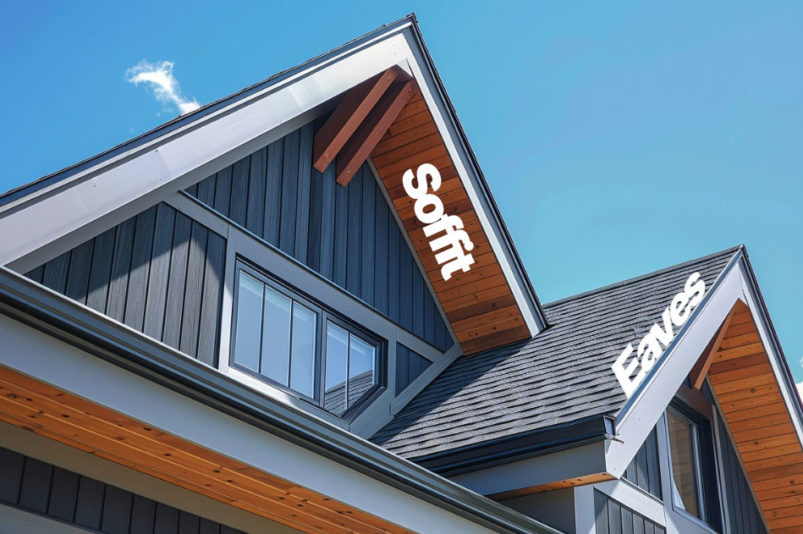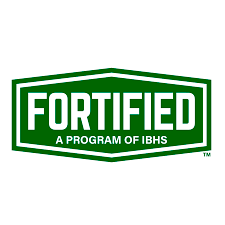
Eaves and soffits might not be the most glamorous parts of a house, but they play big roles in protecting and enhancing your home. Properly distinguishing between these two elements can help you make informed decisions about roofing materials, ventilation, and overall aesthetics, ensuring that your house remains both functional and beautiful.
What Are Eaves
Eaves are the edges of the roof that extend beyond the walls of the house. They may seem simple, but these extensions serve multiple purposes that are essential for the longevity and functionality of your home.
Functions and Purposes of House Eaves:
- Water Management: One of the primary roles of eaves is to direct rainwater away from the walls and foundation of the house. By extending beyond the walls, eaves help prevent water from seeping into the structure, which can lead to mold, rot, and other water damage.
- Protection from the Elements: Eaves provide shade and shelter, protecting windows, doors, and siding from direct sunlight and precipitation. This reduces wear and tear on these components and can improve the energy efficiency of your home.
- Aesthetic Appeal: Architecturally, eaves contribute to the overall look of a house. They can be styled in various ways to complement the design of the home, adding to its curb appeal.
Exploring Soffits
Soffits are located on the underside of the eaves, forming a bridge between the edge of the roof and the exterior wall of the house. They are often perforated or vented to allow airflow into the attic or roof space.
Functions and Purposes of Soffits:
- Ventilation: One of the key roles of soffits is to provide ventilation to the attic and roof space. Proper ventilation helps regulate temperature and moisture levels, preventing issues like mold growth and ice dams in colder climates.
- Protection: Soffits protect the underside of the roof overhang and the rafters from weather elements such as rain, wind, and pests. This extends the life of the roof structure by preventing moisture and animal intrusion.
- Aesthetic Enhancement: Soffits contribute to the finished look of a house by covering the exposed rafters and beams. They come in various materials and styles, allowing homeowners to match them with the overall design of the home.
Materials for Soffits
Choosing the right material for your soffits is important, not just for functionality but aesthetics as well. Here are some common materials used for soffits and their pros and cons:
Vinyl Soffits:
- Pros: Vinyl is cost-effective, durable, and requires minimal maintenance. It is also resistant to rot, insects, and moisture.
- Cons: Limited color options and may fade over time due to sun exposure.
Aluminum Soffits:
- Pros: Aluminum is lightweight, durable, and available in many colors. It is also resistant to rust and can be painted to match the house’s exterior.
- Cons: More expensive than vinyl and can dent or scratch more easily.
Wood Soffits:
- Pros: Wood offers a natural and classic look, with the ability to be painted or stained to match the home’s design.
- Cons: Requires regular maintenance to prevent rot, warping, and insect damage. It is also more expensive and less durable in harsh weather conditions.
Fiber Cement Soffits:
- Pros: Extremely durable and resistant to fire, rot, and insects. It can also be painted to match any exterior.
- Cons: Heavier and more expensive than other options. Installation can be more complex due to its weight.
Each material has its advantages and disadvantages, so it’s important to consider factors like budget, climate, and desired aesthetic when selecting soffits for your home.
Overlapping Features
While eaves and soffits are distinct components, they share several overlapping features that contribute to the overall functionality and aesthetics of your home.
Unified Protection: Together, eaves and soffits protect your home from the elements. Eaves direct water away from the walls and foundation, while soffits prevent moisture and pests from entering the roof structure.
Ventilation: Soffits often incorporate vents that facilitate airflow, working in tandem with eaves to maintain proper attic ventilation. This helps regulate temperature and moisture levels, reducing the risk of mold and ice dam formation.
Aesthetic Integration: Both eaves and soffits contribute to the architectural style of a house. Eaves provide a distinct roofline, and soffits offer a polished finish to the underside of the overhang. Together, they enhance the visual appeal of the home.
Benefits of Soffits
Installing soffits offers several benefits that enhance the functionality and value of your home.
Enhanced roof protection is one of the primary advantages of soffits. They shield the underside of the roof overhang from weather elements such as rain, snow, and wind, extending the life of the roof structure by preventing moisture infiltration and subsequent damage. Additionally, installing soffits can potentially increase the value of a home. A well-maintained and aesthetically pleasing exterior demonstrates that the homeowner has taken steps to protect and enhance the property.
From an aesthetic perspective, soffits provide a clean and finished look to the roofline, hiding the exposed rafters and beams. Available in various styles and colors, they allow homeowners to match or complement the exterior design of their home, enhancing curb appeal.
Another significant benefit is the reduced maintenance needs. Soffits made from durable materials like vinyl or aluminum resist rot, insects, and weather damage, reducing the need for frequent repairs or replacements.
Soffit Ventilation Options
Proper ventilation is crucial for maintaining the health and longevity of your roof and attic. Soffits play a key role in ventilation by providing an entry point for fresh air, which helps regulate temperature and moisture levels.
Types of Soffit Ventilation:
- Continuous Venting: This type of soffit vent runs the entire length of the eave, providing consistent airflow into the attic. Continuous vents are effective at promoting uniform ventilation, reducing the risk of hot spots and moisture buildup.
- Individual Vent Panels: These are spaced at regular intervals along the soffit. While they may not provide as much ventilation as continuous vents, they are easier to install and can be placed where needed most.
- Perforated Soffit Panels: These panels have small holes or slits that allow air to pass through. They offer a balance between aesthetics and functionality, blending seamlessly with the soffit while providing adequate ventilation.
Importance of Proper Ventilation:
Without proper ventilation, your attic can become a breeding ground for mold and mildew due to trapped moisture. Additionally, inadequate airflow can cause the roof to overheat in the summer, leading to higher energy bills and potential damage to the roofing materials. Properly ventilated soffits help mitigate these issues, ensuring a healthy and efficient home.
Get More Clarification
To sum up the difference between eaves and soffits: Eaves direct water away from your house, protecting it from moisture damage, while soffits provide crucial ventilation and protection for the roof’s underside.
However, if this is a topic you would like clarification on, or want to know how a professional roofer can help, give Presidio Roofing a call at (210) 880-9977.





